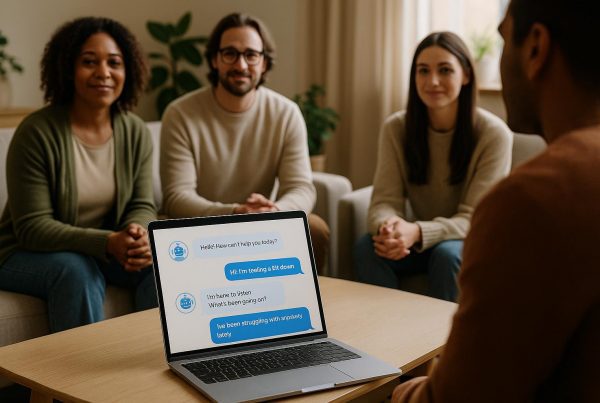Can AI replace human coaches? Not entirely. Both AI and human coaches have strengths and weaknesses, and their approaches to building trust differ significantly.
- Human Coaches: Excel in empathy, emotional intelligence, and personal connection. They interpret non-verbal cues, adapt to cultural contexts, and provide tailored insights. However, they are limited by availability, scheduling constraints, and potential biases.
- AI Coaches: Shine in data-driven precision, 24/7 availability, and consistent support. They use algorithms to mimic empathy, track progress, and provide evidence-based techniques like CBT and DBT. Yet, they may lack the emotional depth and intuition of human coaches.
Quick Comparison
| Aspect | Human Coaches | AI Coaches |
|---|---|---|
| Empathy | Deep emotional understanding | Simulated empathy via algorithms |
| Availability | Limited to scheduled sessions | 24/7 support |
| Emotional Intelligence | Intuitive and nuanced | Pattern recognition and sentiment analysis |
| Bias | Prone to unconscious biases | Reduced through data-driven processes |
| Cost | $7,000–$25,000 per manager annually | More affordable and scalable |
| Crisis Response | Tailored and empathetic | Instant detection and escalation |
Key Takeaway:
A hybrid approach works best. AI offers scalability and efficiency, while human coaches provide emotional depth and personalized guidance. Together, they create a balanced system for effective coaching.
AI vs Human Connection: The True Power of Human Coaching
Core Elements of Trust
Trust is the cornerstone of any successful coaching relationship. It thrives on thoughtful questioning, active listening, and genuine empathy [2]. While both AI and human coaches aim to establish trust, they approach it in distinct ways.
Empathy in Practice
Human coaches draw on their personal experiences and cultural understanding to connect with clients on a deeper level [3]. Dr. Marshall Goldsmith, a well-known executive coach, highlights this unique human advantage:
"AI can support human coaches by providing valuable data and enabling more focused coaching sessions, but it cannot replace the human touch that makes coaching transformative" [5].
On the other hand, AI systems like Aidx.ai’s Adaptive Therapeutic Intelligence (ATI) System™ simulate empathy through carefully programmed responses. These systems adjust to users’ emotional cues, and studies suggest they can effectively replicate compassion [4].
However, building trust isn’t just about emotional connection – it also requires protecting client data.
Privacy and Data Protection
Human coaches adhere to strict ethical standards to maintain confidentiality. They ensure privacy through secure communication, limited data access, and anonymization of sensitive information. As Balsam Abdulghani, Senior Lecturer at HU, explains:
"Coaches and mentors can ensure clients’ data privacy and security by educating them, using secure communication channels and storage, limiting access to data, anonymizing sensitive information, minimizing data collection, conducting regular audits, implementing backup procedures, staying informed about relevant regulations, obtaining client consent, and using secure payment processing methods" [6].
Similarly, Aidx.ai prioritizes data security with features like full GDPR compliance, end-to-end encryption, automatic session deletion in Incognito Mode, and regular security audits. Importantly, no human oversight occurs unless legally mandated.
With emotional and data trust secured, the next key element is consistent and reliable support.
Reliable Support
Consistency plays a critical role in fostering trust. As Lisa DeAngelis observes:
"One of the things that will make or break a coaching relationship is the level of trust and honesty between the coach and the client" [7].
AI offers 24/7 availability, consistent methodologies, regular check-ins, and automated follow-ups, ensuring steady guidance. Human coaches, meanwhile, build reliability through meaningful personal connections, adaptable communication styles, and tailored accountability – despite the limitations of time.
Ultimately, trust in coaching hinges on open communication, authentic care, and steadfast support throughout the journey [8].
Reading Emotions: Human vs AI Coaches
Human Understanding of Emotions
Human coaches have an innate ability to interpret emotional nuances through non-verbal cues and subtle shifts in tone. Their emotional awareness allows them to connect deeply with clients, often uncovering feelings that might not be explicitly expressed. As Carly Anderson, MCC, aptly puts it:
"To be human is to feel." [9]
This statement captures the essence of how human coaches naturally empathize with their clients’ emotional journeys. The International Coach Federation (ICF) emphasizes emotional intelligence in its Core Competencies, highlighting skills like "Embodies a Coaching Mindset" and "Maintains Presence" [9].
Dr. David Goleman’s research reinforces the importance of emotional intelligence (E.Q.), identifying it as a key predictor of workplace success [11]. Human coaches harness this understanding in several ways:
- Observing body language and facial expressions during interactions
- Interpreting cultural and contextual subtleties
- Drawing on their own emotional experiences to relate to clients
While human coaches rely on intuition and personal insight, AI coaches take a different route, using systematic analysis to interpret emotions.
AI Emotion Processing
AI coaching systems, on the other hand, use advanced algorithms to detect and interpret emotions. For instance, Aidx.ai’s Adaptive Therapeutic Intelligence (ATI) System™ employs natural language processing and sentiment analysis to assess emotional states. It evaluates factors like voice intonation, speech patterns, word choice, and conversation history to form a comprehensive emotional understanding.
The growing demand for emotional AI is evident, with the market projected to reach $7 billion by 2029, growing at a 13.34% annual rate [12]. Current sentiment analysis tools boast impressive accuracy, achieving up to 96% in identifying emotional tones within text data [10].
Aidx.ai’s voice-enabled platform further enhances emotional recognition by offering:
- Real-time analysis of voice intonation and rhythm
- Pattern recognition across multiple sessions
- Adaptive, context-aware responses
- Round-the-clock availability for consistent support
Although AI cannot replicate the instinctive empathy of human coaches, it brings distinct advantages to the table:
| Aspect | Capability |
|---|---|
| Data Processing | Instantly analyzes vast amounts of emotional data |
| Consistency | Maintains steady and predictable responses |
| Memory | Perfectly recalls entire conversation histories |
| Availability | Offers 24/7 emotional support |
Together, these unique strengths highlight how AI complements human coaching. While humans excel in emotional intuition, AI provides precision, consistency, and accessibility, creating a balanced approach to emotional support.
24/7 Support vs Scheduled Sessions
Always-Available AI Support
The way coaching support is delivered has undergone a major shift with the rise of AI platforms that are accessible 24/7. Studies show that 50% of therapy seekers struggle to find timely support [14], exposing a clear gap in traditional coaching methods.
Aidx.ai’s Adaptive Therapeutic Intelligence (ATI) System™ is designed to fill this gap, offering on-demand, voice-enabled support. Here’s who benefits the most:
- Global teams working across multiple time zones
- Professionals dealing with urgent challenges outside standard business hours
- Individuals needing immediate support during critical moments
This kind of availability is a game-changer, especially when you consider that 82% of new managers step into leadership roles without formal training [13]. With AI coaching platforms available around the clock, individuals can access the guidance they need, exactly when they need it.
Time Constraints of Human Coaches
On the flip side, human coaches operate within the limits of scheduled sessions and fixed working hours. Traditional coaching setups often come with challenges, such as:
| Aspect | Challenge | Impact |
|---|---|---|
| Session Frequency | Bi-monthly or monthly meetings | Loss of urgency and relevance for topics |
| Scheduling | Limited time slots | Long wait times for support |
| Cost Implications | $7,000 to $25,000 per manager annually [15] | Restricts access for many professionals |
| Availability | Business hours only | Little to no support during critical moments |
These limitations highlight the difficulty of relying solely on human coaches for timely guidance. The issue becomes even more pressing when 72% of leaders report feeling "used up" by the end of the day [13].
John Mattox, Head of Talent Development Research at CoachHub, puts it well:
"AI is not about replacing coaches but about enhancing their effectiveness by offering continuous, data-driven feedback" [5]
This kind of continuous support is invaluable, especially in situations where waiting for a scheduled session could reduce the impact of coaching. AI coaching platforms make it possible for organizations to provide consistent, on-demand support while keeping costs manageable. This is particularly crucial as 60% of leaders will require training in AI-related skills by 2025 [13].
sbb-itb-d5e73b4
Bias and Decision-Making
Both AI and human coaches face the challenge of making decisions while addressing bias. This issue is more prevalent than many realize – 67% of recruiters admit they unconsciously prefer candidates from familiar universities or industries [17].
AI’s Systematic Approach
Aidx.ai’s Adaptive Therapeutic Intelligence (ATI) System™ takes a structured, data-driven approach to reduce bias. Here’s how it works:
| Method | Implementation | Outcome |
|---|---|---|
| Pattern Recognition | Uses machine learning to identify relevant variables [16] | Limits subjective interpretation |
| Decision Transparency | Allows audits of coaching recommendations [16] | Supports continuous improvement |
| Fairness Constraints | Applies pre- and post-processing techniques [16] | Reduces demographic biases |
This systematic approach ensures objectivity in AI-driven decisions. Andrew McAfee, a researcher at MIT, sums it up well:
"If you want the bias out, get the algorithms in." [16]
On the other hand, human coaches often grapple with biases shaped by their personal experiences.
Human Coach Bias Factors
Human coaches are prone to several types of biases, including:
- Affinity Bias: Favoring clients who share similar backgrounds or perspectives, often unconsciously [18].
- Attribution Bias: Misjudging success or failure based on personal experiences rather than objective evidence. Karen Boskemper, PCC, explains:
"A bias is a belief (or attitude) that we hold as being true, but in fact may be only one perspective. But is the belief we hold the ‘right’ or ‘true’ belief to have?" [19]
- Confirmation Bias: Seeking information that aligns with initial impressions while ignoring contradictory evidence [18].
Here’s a striking example: although less than 4% of American men are taller than 6’2", they make up over 36% of corporate CEOs [19]. Such patterns highlight how biases can distort decision-making.
To tackle these challenges, Aidx employs its ‘3D Question Framework: Data, Distortion, Alternative’ [17], which anchors insights in objective analysis.
The main distinction between AI and human coaches lies in consistency. Human coaches must actively identify and address their biases through training and supervision [18]. In contrast, AI systems rely on fairness constraints and data-driven processes to maintain objectivity and refine decisions over time [16].
Customizing Coaching Methods
Tailoring coaching techniques to fit individual needs is key to meaningful personal growth. Both AI-powered systems and human coaches adjust their methods to provide the most effective and personalized support possible.
AI Pattern Recognition
Aidx.ai’s Adaptive Therapeutic Intelligence (ATI) System™ uses advanced analytics to customize coaching based on voice, behavior history, progress toward goals, and emotional states. By processing specific types of data, the system delivers highly tailored interventions:
| Data Type | Analysis Method | Customization Outcome |
|---|---|---|
| Voice Patterns | Speech recognition | Adjusts communication style |
| Interaction History | Tracking past behavior | Refines intervention strategies |
| Goal Progress | Performance metrics | Modifies challenge levels |
| Emotional States | Digital phenotyping | Adapts therapeutic techniques |
The ATI System™ incorporates techniques like CBT, ACT, DBT, and NLP, refining its approach in real time based on user feedback. While AI relies on hard data to make adjustments, human coaches bring a different kind of personalization to the table – one rooted in intuition and lived experience.
Doug Stephen, president of enterprise learning at CGS Immersive, explains how AI’s data-driven approach benefits organizations:
"AI captures data points – frequency of skill practice, scenario completion rates, user sentiment over time – that quantify behaviour change. This data is fed back into leadership scorecards or HR dashboards, allowing organisations to calculate ROI more precisely." [1]
Human Experience-Based Guidance
Human coaches, on the other hand, excel at using intuition and experience to craft personalized strategies. They can interpret subtle emotional cues, adapt to cultural contexts, and make on-the-spot adjustments based on how a client responds. This nuanced approach is often difficult for AI to replicate.
Maya Gudka, an executive coach at London Business School, highlights this difference:
"AI is great for offering options but there can still be a gap when it comes to crystallising these into something that ‘feels’ right for the individual." [1]
Jessica Clarke, global head of talent and learning at Atlas Copco, adds:
"The human coach is about shifting mindsets, holding up the mirror, looking at the body language. It’s the transformational space as opposed to the performance-based coaching of AI." [1]
Research published in Nature Human Behaviour supports the importance of personalization in coaching. The study found that customized interventions can significantly improve mental health outcomes by identifying behavioral patterns unique to each person [20]. This highlights how AI’s data-driven precision and the intuitive, empathetic guidance of human coaches work together to create a more comprehensive approach to personal development.
Emergency Response Methods
In critical situations, acting quickly can make all the difference. While speed is essential, ensuring user safety also relies on effective strategies. AI platforms and human coaches bring unique strengths to crisis management, each playing a vital role in addressing emergencies.
AI Safety Systems
Aidx.ai’s Adaptive Therapeutic Intelligence (ATI) System™ leverages cutting-edge technology to detect and respond to crises in real time. This system monitors conversations for signs of distress through:
- Voice pattern analysis to identify emotional distress.
- Natural language processing (NLP) to flag crisis-related language.
- Real-time risk assessment algorithms to evaluate urgency.
- Automated escalation procedures for immediate action.
The ATI System™ responds within seconds – critical in emergencies, as survival rates drop by 7–10% for every minute without intervention [21].
"While these results are very promising, no generative AI agent is ready to operate fully autonomously in mental health where there is a very wide range of high-risk scenarios it might encounter." – Michael Heinz, Assistant Professor of Psychiatry at CTBH and Geisel School of Medicine [23]
The ATI System™ employs a three-tier protocol to ensure safety:
| Level | Triggers | Actions |
|---|---|---|
| Level 1 – Mild | Signs of stress | Provides immediate coping strategies and grounding techniques |
| Level 2 – Moderate | Anxiety patterns | Offers crisis resources and, when needed, notifies a human coach |
| Level 3 – Severe | Emergency markers | Escalates to crisis services and alerts human responders immediately |
While automation ensures rapid response, human coaches bring depth and empathy to crisis management.
Human Crisis Response
Human coaches play a pivotal role in managing crises by combining emotional intelligence with real-world experience. Their methods include:
Quick Evaluation and Tailored Support: Coaches can assess complex emotional states and adapt their responses based on subtle, context-specific cues that AI might overlook. This personalized approach is key in navigating the nuances of human behavior.
Resource Coordination: Experienced coaches have access to established networks of emergency services, enabling them to connect clients with the right resources quickly. For instance, the NHS demonstrates how AI can detect warning signs, but human intervention is essential for offering empathetic and culturally sensitive care [22]. Similarly, Crisis Text Line integrates AI to prioritize high-risk cases, while human counselors take the lead in response efforts [22].
Conclusion: Combining AI and Human Coaching
Data highlights that 51% of individuals prefer a combination of AI and human coaching, compared to just 15% who favor AI-only coaching [24]. This preference underscores the value of blending the strengths of both approaches to foster trust and effectiveness in coaching relationships.
The ATI System™ by Aidx.ai exemplifies this balance, offering round-the-clock support, precise data insights, and dependable tracking. This dual approach fills the gaps that either AI or human coaching alone might leave behind.
While AI delivers scalability and efficiency, human coaches remain indispensable for their ability to understand and address emotional nuances. In fact, 59% of L&D professionals acknowledge AI’s limitations in navigating emotional and cultural complexities [24]. This makes a hybrid model – where digital precision meets human empathy – a powerful solution.
Here’s how this partnership works:
- AI takes care of the essentials: routine guidance, data analysis, and performance tracking.
- Human coaches bring the personal touch: offering tailored insights and focused interventions.
- Together, they create a balanced system: scalable yet deeply personal support.
The results speak for themselves. When Accenture incorporated AI into their human coaching program, they saw a 30% boost in employee retention over two years [24]. This demonstrates the tangible benefits of combining AI’s efficiency with the emotional intelligence of human coaches.
FAQs
How can AI and human coaches collaborate to improve personal growth and development?
AI and human coaches work together seamlessly by blending the precision of technology with the warmth of human interaction. AI offers instant support, customized insights, and feedback based on data, making coaching accessible 24/7. This helps users stay on track, set meaningful goals, and tackle challenges as they come up.
Meanwhile, human coaches bring empathy, insightful understanding, and the ability to handle complex, personal situations that require a human touch. By combining forces, this partnership creates a dynamic coaching model: AI manages repetitive tasks and provides consistent support, while human coaches focus on building relationships and addressing more intricate needs. Together, they deliver a well-rounded coaching experience designed to support personal growth.
How does Aidx.ai protect my privacy and ensure data security?
Aidx.ai takes your privacy and security seriously, implementing advanced measures to keep your data safe. All your information is encrypted both during storage and transmission, ensuring it stays confidential. Plus, the platform complies with GDPR and HIPAA standards, meeting strict privacy regulations. Importantly, no human reviews your data unless it’s legally required.
You’re always in control of your information. You can delete your data anytime, and Aidx.ai also uses automated protocols to remove data when it’s no longer needed. Wherever possible, data is processed locally for added security. Built by IT security experts, the platform’s strong framework shields against potential risks, so you can use it with confidence.
How does AI recognize and respond to emotions compared to human coaches?
AI systems leverage advanced algorithms to pick up on emotional cues such as vocal tone, speech patterns, and even facial expressions in some cases. By analyzing these signals, AI can determine emotions like happiness, frustration, or sadness and adjust its responses to suit the situation. For instance, if it detects a quicker speaking pace as an indicator of stress, it might suggest calming techniques or offer supportive advice.
In contrast, human coaches rely on emotional intelligence to sense and respond to emotions. They can read subtle signs like body language or unspoken feelings, demonstrating empathy and genuine understanding. This ability to connect personally helps human coaches build trust and adapt their methods to provide a coaching experience that feels more meaningful. While AI excels in consistency and instant support, human coaches offer the emotional depth and connection that technology simply can’t replicate.



